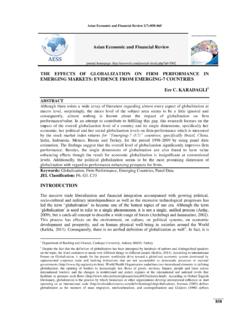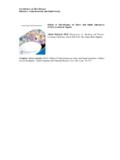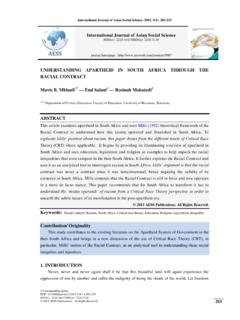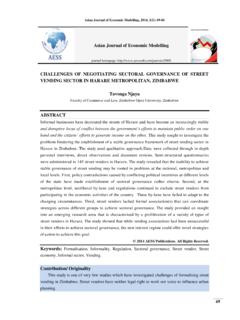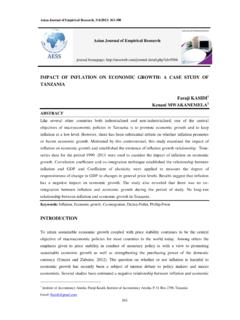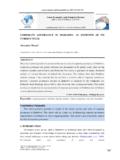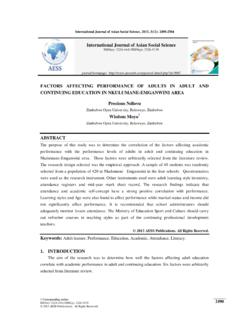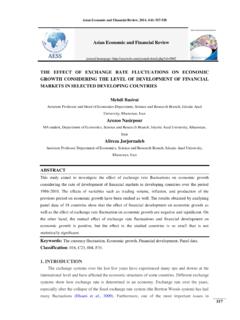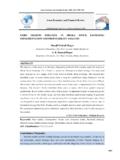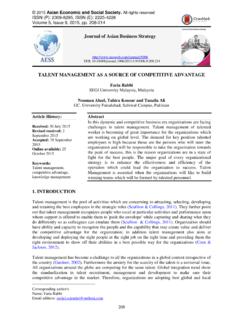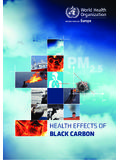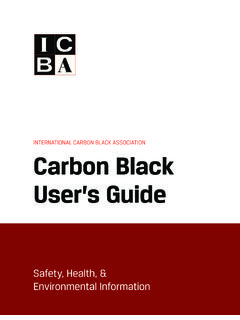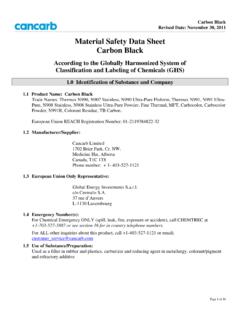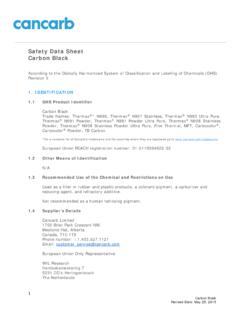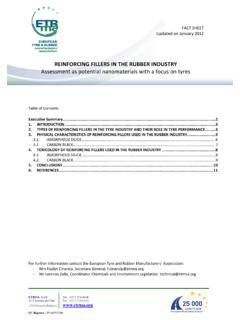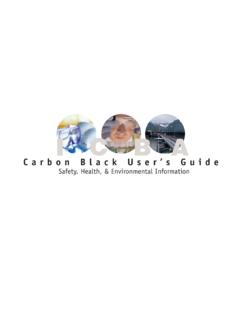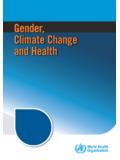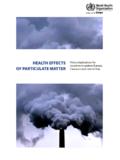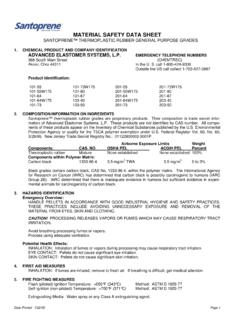Transcription of STUDY OF THE HEALTH EFFECTS OF COAL MINING ON COAL …
1 International Journal of Asian Social Science, 2013, 3(7):1572-1590 Corresponding author ISSN(e): 2224-4441/ISSN(p): 2226-5139 2013 AESS Publications. All Rights Reserved. 1572 STUDY OF THE HEALTH EFFECTS OF COAL MINING ON COAL MINE WORKERS OF BALUCHISTAN Salahuddin Din Azad Baluchistan University of Information technology, Engineering and Management Sciences Maqsood Ahmad Khan Baluchistan University of Information technology, Engineering and Management Sciences Quetta Baluchistan Muhammad Ishaque Ghaznavi Dean of Marine water Sciences Lasbela University Baluchistan Shereen Khan Assistant Professor Bolan Medical College Quetta Baluchistan ABSTRACT The average emission and prevalence of Methane (CH4), Carbon monoxide (CO), and Oxygen (O2)measured as , 36ppm and 14% respectively which exceeds the permissible limits of 1-10m3/ton, 30ppm and 18 %( Standardized by National institute of occupational safety and HEALTH (NIOSH )and are the sources of higher death ratio.)
2 The higher concentration of coal dust (Carbon and Quartz) have been measured as 4-5mg/m3 and against the threshold limits (Recommended by NIOSH) of 2mg/m3 and mg/m3 for 8hours daily and 40hours/week. Due to high concentration of coal dust the coal workers of Baluchistan are experiencing the diseases like Routine headache, irritation in throat ,nose, and eyes drowsiness, shortness of breath, Nausea,pneumoconiosis, tuberculosis, chronic obstructive bronchitis, heart problems, Impacts on genetic integrity of workers reproductive and fertility problems, respiratory irritation, asthmatic and even lung impairment and lung cancer problem. The coal water and slurry being the residual of coal MINING are disposed off in an unconfined area which becomes the source of water contamination which is used by coal workers and has several HEALTH impactslike Ulcer, Diarrhea, cholera, Hepatitis B and C etcon coal workers of Baluchistan.
3 2013 AESS Publications. All Rights Reserved. Keywords: Environmental Protection Agency (Department of labor), Chronic obstructive pulmonary disease (COPD) Threshold limit values (TLVS), Coal Workers pneumoconiosis (CWP), Pulmonary Function test (PFT), Permissible exposure limit(PEL), Car boxy hemoglobin(COHB), International Journal of Asian Social Science ISSN(e): 2224-4441/ISSN(p): 2226-5139 journal homepage: International Journal of Asian Social Science, 2013, 3(7):1572-1590 2013 AESS Publications. All Rights Reserved. 1573 Tuberculosis( ), National Institute of Occupational Safety and HEALTH (NIOSH), Occupational Safety and HEALTH administration(OSHA), Mine Safety and HEALTH Administrative(MSHA) 1. INTRODUCTION The basic reason to declare the coal MINING as the harmful profession in Baluchistan is the uncontrolled emission and exposure to carbon monoxide and methane both being greenhouse gases and are harmful not to the environment but to coal workers as well.
4 Theover exposure of methane gas (Greenhouse Gas) causes the sudden death whichis quite frequent in accidents due to roof collapse inside the mine because of old MINING techniques are quite common, and it has become overburden on Government of Baluchistan in the shape of compensation and treatment expenditures. Exposure to over emission of coal dust is another phenomenon which has given rise to numerous HEALTH problems. In Balochistanthere is no concept of disposal of coal effluents atconfined place,so it has become not only the source of air,water and soil degradation but has posed numerous waterborne HEALTH problems 2. MATERIAL AND METHODS It describes the procedure adopted for the conduct of research work in the field, collection of data, experimental material used in the field, STUDY area, Medical and Laboratory services and statistical tools practiced to identify the problem areas due to coal MINING in Baluchistan.
5 Studies to determine occupational HEALTH impacts on coal mine workers of Baluchistan were conducted in the coal fields in Mach, Sorangedegari and chamalong. It was quite difficult to conduct the research work in Baluchistan due to the unrest and security situation; therefore the Military services were sought in the field as shown in (Figure; 1) Methods Used to Identify the HEALTH Impacts of Coal Workers To carry out the research in the field, a comprehensive plan was made in which three coal mines were selected for STUDY purpose. A comprehensive Questionnaire, covering all the details, was formulated to get the qualitative and quantitative data about the coal mine workers HEALTH impacts in selected coal mine fields and a based Quality of life (QOL) questionnaire was also used to ascertain the quality of life and HEALTH EFFECTS of coal workers in Baluchistan.
6 The high quality analytical equipment of Baluchistan Environmental Protection (BEPA) was mobilized and used on all three selected coal mine sites to find out the EFFECTS of coal dust, coal waste and coal gases exposure on the HEALTH of coal mine workers. To ascertain the specific and precise harmful impacts such as common clinical problems, like respiratory irritation, pulmonary tuberculosis, pneumoconiosis(black lung), obstructive bronchitis, allergy, male infertility and heart diseases etc being related to physical and biological hazards of work environment, the selected coal workers were taken to Combined Military Hospital for the medical examination like X-ray, sputum, blood and urine routine examination, semen analysis, CT scan, biopsy, and ultrasound etc. 3. DATA COLLECTION For the collection of secondary data, different departments of Government of Baluchistan were approached (Table1).
7 International Journal of Asian Social Science, 2013, 3(7):1572-1590 2013 AESS Publications. All Rights Reserved. 1574 Types of Equipment Used to Identify the HEALTH EFFECTS During the field work, the data on the mentioned parameters that could havethe HEALTH impactson coal miners were collected with the help of apparatus given in the table(2) Research Area and Sample Size Keeping in view the security situation, total no of mines selected and allowed to visit by authority, Geographical location, types of MINING carried out, the three coal mine fields named as Mach, So-range-Degari, and Chamalong coal fields were selected for STUDY purpose. For the simplicity and to be more specific three sub-mines from each selected coal fields were selected and marked as M1,M2,andM3 at Mach coal field, SD1, SD2 and SD3 at So-range-Degari and C1, C2 and C3 at Chamalong coal fields. Approximate 10% strength of coal workers out of sample size 228 was selected for further analysis.
8 The strength of coal workers selected from respective mines is given in table 3; Mach (M1, M2, M3) = 65 coal workers. So-range -Degari (SD1, SD2, SD3) =77 Coal Workers and Chamalong (C1, C2, C3) = this way total strength of coal workers selected n= 228 coal workers for STUDY purpose, so this figure can be denoted (n=228) Moreover a total of 120 Non coal workers 30, 40, and 50 respectively from living areas near to each selected coal field were selected for comparison purpose. The idea was to ascertain whether the population adjacent to coal fields approximately within one kilometer is affected due to coal MINING or not. The data was collected by face to face interviews, coal workers were read out the Questionnaireeven the questionnaire was translated into the language which they can understand/ read out. The average timing for the completion of questionnaire was 36 minutes.
9 For coal dust workers and non coal workers the age ranges between 15-45 and above with medium age of 32 years of coal drillers, helpers, coal loaders (Labors) and coal transporters were 60%, 15%, 20% and 5% respectively. The total strength of coal workers was further divided into four age group table 4 Methods of Investigation Through Questionnaire The reliability of the QOL Brief scales was calculated, usingcronbach sX-coefficient. (Cronbach, 2003),Alpha co-efficient of magnitudes or greater were sought as evidence of adequate scale, reliability for use at the level of group comparison. (Cronbach, 2003).Person s correlation coefficient was used to examine the correlation between the scales (Cronbach, 2003).To examine the Impact of Socio-demographic, working, and HEALTH factors on HEALTH related QOL, the multiple stepwise regression analysis was used in which the dependent variables were the scores of the physical, psychological social and environmental domains of the QOL Brief and the independent variables.
10 For all analysis, a two sided P- value of less than was considered to be statistically significant , statistical description and hypothesis testing were performed by using the statistical software (SPSS)version ( ).Regression analysis was performed using SAS (version ). Methods of Investigation in the Field The services of Environmental Protection Agency (Department of labor)were requested for the provision of Equipment and staff in the field. The coal dust samples at all selected coal mines International Journal of Asian Social Science, 2013, 3(7):1572-1590 2013 AESS Publications. All Rights Reserved. 1575 were collected with the help of Particulate Matter Andersons Samplers (PM10 and )for the Evaluation of coal dust Exposure limits and to ascertain the sizes of inhaled dust particles.(Figure2).The gas detection appliances were used to detect the percentage of Carbon monoxide CO),Methane (CH4) and presence of Oxygen (O2).
